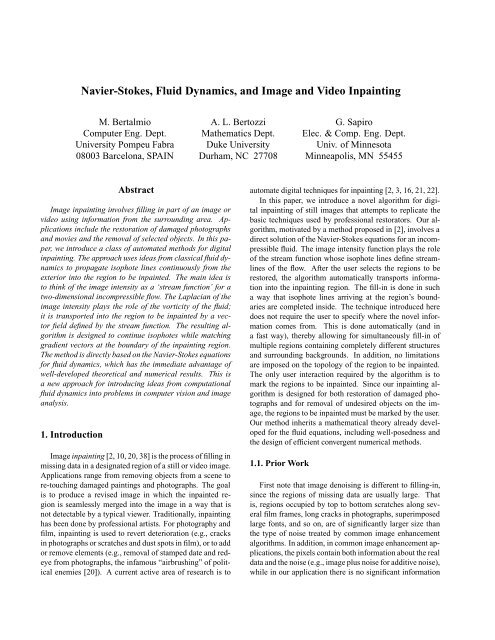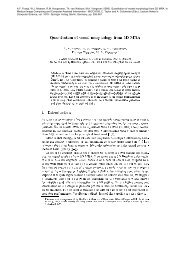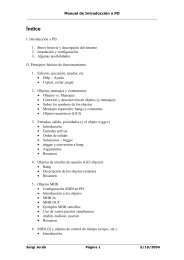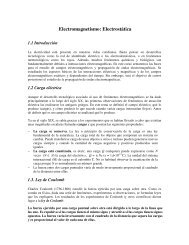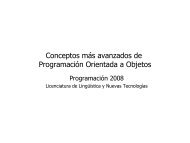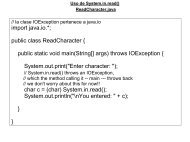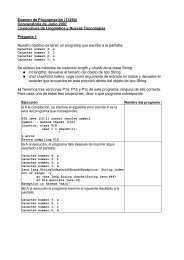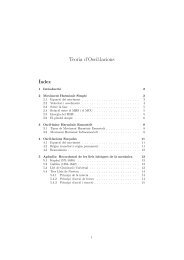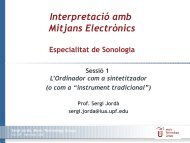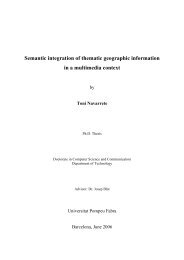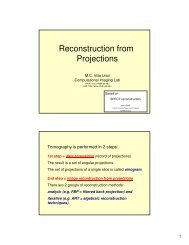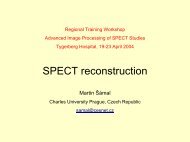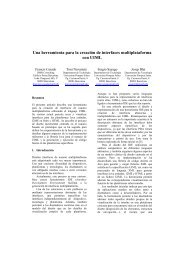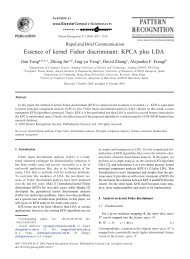Navier-Stokes, Fluid Dynamics, and Image and Video Inpainting
Navier-Stokes, Fluid Dynamics, and Image and Video Inpainting
Navier-Stokes, Fluid Dynamics, and Image and Video Inpainting
Create successful ePaper yourself
Turn your PDF publications into a flip-book with our unique Google optimized e-Paper software.
<strong>Navier</strong>-<strong>Stokes</strong>, <strong>Fluid</strong> <strong>Dynamics</strong>, <strong>and</strong> <strong>Image</strong> <strong>and</strong> <strong>Video</strong> <strong>Inpainting</strong><br />
M. Bertalmio<br />
Computer Eng. Dept.<br />
University Pompeu Fabra<br />
08003 Barcelona, SPAIN<br />
A. L. Bertozzi<br />
Mathematics Dept.<br />
Duke University<br />
Durham, NC 27708<br />
G. Sapiro<br />
Elec. & Comp. Eng. Dept.<br />
Univ. of Minnesota<br />
Minneapolis, MN 55455<br />
Abstract<br />
<strong>Image</strong> inpainting involves filling in part of an image or<br />
video using information from the surrounding area. Applications<br />
include the restoration of damaged photographs<br />
<strong>and</strong> movies <strong>and</strong> the removal of selected objects. In this paper,<br />
we introduce a class of automated methods for digital<br />
inpainting. The approach uses ideas from classical fluid dynamics<br />
to propagate isophote lines continuously from the<br />
exterior into the region to be inpainted. The main idea is<br />
to think of the image intensity as a ‘stream function’ for a<br />
two-dimensional incompressible flow. The Laplacian of the<br />
image intensity plays the role of the vorticity of the fluid;<br />
it is transported into the region to be inpainted by a vector<br />
field defined by the stream function. The resulting algorithm<br />
is designed to continue isophotes while matching<br />
gradient vectors at the boundary of the inpainting region.<br />
The method is directly based on the <strong>Navier</strong>-<strong>Stokes</strong> equations<br />
for fluid dynamics, which has the immediate advantage of<br />
well-developed theoretical <strong>and</strong> numerical results. This is<br />
a new approach for introducing ideas from computational<br />
fluid dynamics into problems in computer vision <strong>and</strong> image<br />
analysis.<br />
1. Introduction<br />
<strong>Image</strong> inpainting [2, 10, 20, 38] is the process of filling in<br />
missing data in a designated region of a still or video image.<br />
Applications range from removing objects from a scene to<br />
re-touching damaged paintings <strong>and</strong> photographs. The goal<br />
is to produce a revised image in which the inpainted region<br />
is seamlessly merged into the image in a way that is<br />
not detectable by a typical viewer. Traditionally, inpainting<br />
has been done by professional artists. For photography <strong>and</strong><br />
film, inpainting is used to revert deterioration (e.g., cracks<br />
in photographs or scratches <strong>and</strong> dust spots in film), or to add<br />
or remove elements (e.g., removal of stamped date <strong>and</strong> redeye<br />
from photographs, the infamous “airbrushing” of political<br />
enemies [20]). A current active area of research is to<br />
automate digital techniques for inpainting [2, 3, 16, 21, 22].<br />
In this paper, we introduce a novel algorithm for digital<br />
inpainting of still images that attempts to replicate the<br />
basic techniques used by professional restorators. Our algorithm,<br />
motivated by a method proposed in [2], involves a<br />
direct solution of the <strong>Navier</strong>-<strong>Stokes</strong> equations for an incompressible<br />
fluid. The image intensity function plays the role<br />
of the stream function whose isophote lines define streamlines<br />
of the flow. After the user selects the regions to be<br />
restored, the algorithm automatically transports information<br />
into the inpainting region. The fill-in is done in such<br />
a way that isophote lines arriving at the region’s boundaries<br />
are completed inside. The technique introduced here<br />
does not require the user to specify where the novel information<br />
comes from. This is done automatically (<strong>and</strong> in<br />
a fast way), thereby allowing for simultaneously fill-in of<br />
multiple regions containing completely different structures<br />
<strong>and</strong> surrounding backgrounds. In addition, no limitations<br />
are imposed on the topology of the region to be inpainted.<br />
The only user interaction required by the algorithm is to<br />
mark the regions to be inpainted. Since our inpainting algorithm<br />
is designed for both restoration of damaged photographs<br />
<strong>and</strong> for removal of undesired objects on the image,<br />
the regions to be inpainted must be marked by the user.<br />
Our method inherits a mathematical theory already developed<br />
for the fluid equations, including well-posedness <strong>and</strong><br />
the design of efficient convergent numerical methods.<br />
1.1. Prior Work<br />
First note that image denoising is different to filling-in,<br />
since the regions of missing data are usually large. That<br />
is, regions occupied by top to bottom scratches along several<br />
film frames, long cracks in photographs, superimposed<br />
large fonts, <strong>and</strong> so on, are of significantly larger size than<br />
the type of noise treated by common image enhancement<br />
algorithms. In addition, in common image enhancement applications,<br />
the pixels contain both information about the real<br />
data <strong>and</strong> the noise (e.g., image plus noise for additive noise),<br />
while in our application there is no significant information
in the region to be inpainted.<br />
A very active area related to our work is the restoration<br />
of damaged films. The basic idea is to use information<br />
from past <strong>and</strong> future frames to restore the current one,<br />
e.g., [16, 22]. Of course, this general approach cannot be<br />
used when dealing with still images. In addition, it can<br />
not deal with movies where the region to be inpainted is<br />
static with respect to its background (e.g., a logo on a shirt),<br />
since consecutive frames do not provide new information.<br />
This is also the case when the region to be inpainted occupies<br />
a large number of frames. Another area related to<br />
our work is texture synthesis, in which a texture is selected<br />
<strong>and</strong> synthesized inside the region to be filled-in (the hole)<br />
[9, 13, 15, 34]. These algorithms often require the user to<br />
select the texture <strong>and</strong> are not often well-designed to fill in<br />
structure from boundary data.<br />
The closest methods to our approach are the fundamental<br />
works on disocclusion <strong>and</strong> line continuation. A pioneering<br />
contribution in this area is described in [28]. The authors<br />
presented a technique for removing occlusions with the goal<br />
of image segmentation. Since the region to be filled-in can<br />
be considered as occluding objects, removing occlusions is<br />
analogous to image inpainting. The basic idea suggested<br />
by the authors is to connect T-junctions at the occluding<br />
boundaries of objects with elastica minimizing curves. The<br />
technique was primarily developed for simple images obtained<br />
from a segmentation, with only a few objects with<br />
constant gray-levels. Thus, they ended up by connecting -<br />
junctions at the same gray level. (Other researchers, e.g., D.<br />
Jacobs, R. Basri, <strong>and</strong> S. Zucker, have followed this interesting<br />
research area, mainly developing techniques for smooth<br />
curve continuation.)<br />
Masnou <strong>and</strong> Morel [25, 26] recently extended these<br />
ideas, presenting a formal variational formulation for disocclusion<br />
<strong>and</strong> a particular practical implementation. The<br />
algorithm uses geodesic curves to join the isophotes arriving<br />
at the boundary of the region to be inpainted. The inpainting<br />
regions require a simple topology. In addition, the<br />
angle, with which the level lines arrive at the boundary of<br />
the holes, is not (well) preserved, <strong>and</strong> the algorithm uses<br />
straight lines to join equal gray value pixels.<br />
Recently, the concept of smooth continuation of information<br />
in the level-lines direction has been addressed in<br />
[2]. This is the work, as we will see below, that we follow<br />
to make the connection with fluid dynamics <strong>and</strong> the<br />
<strong>Navier</strong>-<strong>Stokes</strong> equations. The proposed algorithm propagates<br />
the image Laplacian in the level-lines (isophotes) direction.<br />
The algorithm attempts to imitate basic approaches<br />
used by professional restorators. The algorithm also introduces<br />
the importance of propagating both the gradient direction<br />
(geometry) <strong>and</strong> gray-values (photometry) of the image<br />
in a b<strong>and</strong> surrounding the hole to be filled-in. Some of<br />
the ideas of [2] where adopted in [1], while deviating from<br />
the particular model in order to be able to define a formal<br />
variational approach to the filling-in/inpainting problem.<br />
The work in [2] inspired a very elegant approach to the<br />
filling-in problem recently reported in [7] (this work was<br />
performed independently of the one reported in [1]). The<br />
authors present a clear <strong>and</strong> intuitive axiomatic approach to<br />
the problem. The main algorithm they propose is to minimize<br />
the Total Variation (TV) [33], of the image inside<br />
the hole (they also use, as proposed in [1, 2] <strong>and</strong> here, a<br />
b<strong>and</strong> surrounding the region). As in the work of Masnou<br />
<strong>and</strong> Morel, their interpolation is limited to creating straight<br />
isophotes, not necessarily smoothly continued from the hole<br />
boundary, <strong>and</strong> mainly is developed (as the authors clearly<br />
state) for small holes. Although straight connections give<br />
visually pleasant results for small holes, it is important to<br />
develop a theory that permits interpolation of level lines<br />
across large gaps, where connecting with straight lines will<br />
be unpleasant even for simple images. In order to obtain<br />
such a smooth interpolation <strong>and</strong> continuation of isophotes,<br />
it is necessary to go into high-order Partial Differential<br />
Equations (PDE’s) or systems of PDE’s, as done in [1, 2]<br />
<strong>and</strong> here (the authors of [7] have also recently introduced<br />
higher order models). Research in perception, from the<br />
Gestalt to more recent work (e.g. [31]) supports the idea<br />
of performing a smooth continuation of the angle of arrival<br />
of the level lines at the gap.<br />
The paper [2] proposes an algorithm designed to project<br />
the gradient of the smoothness of the image intensity in the<br />
direction of the isophotes. The resulting scheme is a discrete<br />
approximation of the PDE<br />
¡£¢¥¤§¦©¨¡¦©¡<br />
for the image intensity , where denotes the perpendicular<br />
gradient ¡ <strong>and</strong> denotes ¦ the Laplace operator<br />
¨ <br />
<br />
! . Additional anisotropic diffusion of the image can<br />
<br />
produce a PDE of the form<br />
¡ ¢ ¤§¦ ¨ ¡"#¦©$¡<br />
¦'<br />
)(+*<br />
¦¡<br />
¦¡<br />
(1)<br />
-, (2)<br />
1.2. <strong>Image</strong> inpainting along isophotes<br />
The goal is to evolve (1) or perhaps more appropriately (2)<br />
to a steady state solution, satisfying the condition in the inpainting<br />
region that the isophote lines, in the<br />
¦<br />
direction<br />
¡<br />
of<br />
¨<br />
, must be parallel to the level curves of<br />
¡<br />
the<br />
¤/.<br />
smoothness<br />
of the image intensity, % which for becomes<br />
¨ ¡"#¦©$¡¤/.<br />
¦<br />
(3)<br />
,<br />
We note that while the authors of [2] present their<br />
method as moving image intensity along isophote lines,<br />
there is another sense in which to think of the dynamics.<br />
Equation (1) is a transport equation that convects the image<br />
&%<br />
*
§<br />
¡<br />
<br />
¢<br />
¤<br />
<br />
§<br />
¢<br />
¤<br />
<br />
<br />
¦<br />
<br />
¤<br />
<br />
<br />
%<br />
<br />
¡<br />
§<br />
¤<br />
¡<br />
<br />
<br />
<br />
¤<br />
%<br />
¡<br />
.<br />
<br />
¡<br />
¦<br />
intensity along level curves of the smoothness, . This<br />
can be seen by noting that (1) is equivalent ¡ ¡ ¤'. ¡¢¡<br />
<br />
¤£<br />
¦<br />
to<br />
where is the ¦£ ¨§<br />
material derivative for<br />
¤<br />
¥£<br />
¦<br />
the<br />
¨ ¡<br />
velocity field . In particular is convected by<br />
§<br />
the ¡ velocity field which is in the direction of § level curves<br />
of the smoothness . In the next section we discuss how<br />
this is related to a classical problem in incompressible fluid<br />
dynamics. Our goal is to make use of ¡ expertise developed<br />
in that field to design better inpainting algorithms.<br />
2. Analogy to Transport of Vorticity in Incompressible<br />
<strong>Fluid</strong>s<br />
Incompressible Newtonian fluids are governed by the<br />
<strong>Navier</strong>-<strong>Stokes</strong> equations, which couple the velocity vector<br />
field © § to a scalar pressure :<br />
, (4)<br />
2.1. The stream function-image intensity analogy<br />
The main analogy that we build on in this paper is the<br />
parallel between the stream function in a 2D incompressible<br />
fluid <strong>and</strong> the role of image intensity function in the in-<br />
¡<br />
painting method described in Section 1.2. This allows us to<br />
design a new inpainting method that will achieve the same<br />
steady equation (3).<br />
Let be a region in the plane in which we want to inpaint<br />
from surrounding data. Assume that the image intensity ¡<br />
is a smooth function (with possibly large gradients) outside<br />
of <strong>and</strong> we know both ¡ <strong>and</strong> ¡ on the boundary .<br />
We now design a ‘<strong>Navier</strong>-<strong>Stokes</strong>’ based method for image<br />
inpainting. In this method the fluid dynamic quantities have<br />
the following parallel to quantities in the inpainting method.<br />
<strong>Navier</strong>-<strong>Stokes</strong><br />
<strong>Image</strong> inpainting<br />
stream function <strong>Image</strong> intensity<br />
fluid velocity ¡<br />
¤§¦ ¨<br />
isophote direction ¦ ¨ ¡<br />
§<br />
vorticity smoothness<br />
In two space dimensions, the divergence free velocity field<br />
possesses a stream function satisfying ¦ ¨ § . In<br />
§<br />
addition, in 2D the <br />
¤ ¦<br />
§ vorticity, , satisfies a very simple<br />
advection diffusion equation, which can be computed<br />
by taking the curl of the first equation in (4) <strong>and</strong> using some<br />
basic facts about the geometry in 2D:<br />
¦<br />
(5)<br />
, §<br />
Note here that in 2D the vorticity is a scalar quantity that<br />
is related to the stream function through the Laplace<br />
¤ .<br />
operator,<br />
. In the absence %<br />
of viscosity ,<br />
we obtain the Euler equations for inviscid flow. Both the<br />
inviscid <strong>and</strong> viscous problems, with appropriate boundary<br />
conditions, are globally well-posed in two space dimensions.<br />
Solutions exist for any smooth initial condition <strong>and</strong><br />
they depend continuously on the initial <strong>and</strong> boundary data<br />
[17, 18, 23, 24, 36, 40].<br />
In terms of the stream function, equation (5) implies that<br />
steady state inviscid flows must satisfy<br />
¦ ¨<br />
¦©<br />
which says that the Laplacian of the stream function, <strong>and</strong><br />
hence the vorticity, must have the same level curves as the<br />
stream function. The analogy to image inpainting in the previous<br />
section is now clear: the stream function for inviscid<br />
fluids in 2D satisfies the same equation as the steady state<br />
image intensity equation (3).<br />
The point is that in order to solve the inpainting problem<br />
proposed in the previous section, we have to find a steady<br />
state stream function for the inviscid fluid equations, which<br />
is a problem possessing a rich <strong>and</strong> well developed history.<br />
¤§.<br />
(6)<br />
fluid viscosity % anisotropic diffusion %<br />
Our goal is to solve a form of the <strong>Navier</strong>-<strong>Stokes</strong> equations<br />
in the region to be inpainted. The method described<br />
next is based on the vorticity-stream form (5) of the <strong>Navier</strong>-<br />
<strong>Stokes</strong> equations, however it is also possible to consider<br />
other methods based on the primitive variables form (4).<br />
For ease of notation we denote by the smoothness ¡<br />
of the image intensity. Instead of solving a transport equation<br />
for ¡ as in (2), we solve a vorticity transport equation<br />
for :<br />
£<br />
¦ ¦ ¦<br />
( * * £ (7)<br />
¦ §<br />
where ( the function allows for anisotropic diffusion of the<br />
smoothness . The image intensity which defines the velocity<br />
¡ ¤ ¦ ¨ ¡<br />
<br />
field in (7) is recovered by solving §<br />
simultaneously<br />
the Poisson problem<br />
¡$¤ ¤/¡<br />
* , (8)<br />
<br />
¤<br />
For , the direct numerical solution of of (7-8) is a<br />
(<br />
classical way to solve both the dynamic fluid equations <strong>and</strong><br />
to evolve the dynamics towards a steady state solution [30].<br />
For fluid problems with % small viscosity , the above dynamics<br />
can take a long time to converge to steady state,<br />
making the method less practical. Instead there are pseudosteady<br />
methods that involve replacing the Poisson equation<br />
(8) with a dynamic relaxation equation<br />
¢ ¡ ¤§.<br />
¤§¡<br />
¡<br />
#$ , (9)<br />
¨ "!<br />
where the parameter determines a rate of relaxation. In<br />
our situation, diffusion can result in a blurring of sharp interfaces,<br />
gradients of , in the inpainting region. Hence it<br />
¡<br />
¦ <br />
¤§.<br />
¦<br />
¤§$¡<br />
¤ <br />
§<br />
&%<br />
§
¤<br />
<br />
§ ©<br />
<br />
<br />
is often desirable to include anisotropic diffusion in the solution<br />
of . This can be added directly to the dynamical<br />
problem (9) or as an additional step in conjunction with the<br />
Poisson step (8). In our test cases with anisotropic diffusion,<br />
we did not find a significant difference between direct<br />
¡<br />
solution of the Poisson equation in (8) versus the relaxation<br />
method (9).<br />
Once steady state is achieved, we have effectively found<br />
a solution of (3) for the intensity (perhaps modified<br />
slightly by the anisotropic diffusion). Hence we expect <strong>and</strong><br />
indeed find that the <strong>Navier</strong>-<strong>Stokes</strong> inpainting method performs<br />
in many ways like the method proposed in [2]. There<br />
¡<br />
are several advantages to using the <strong>Navier</strong>-<strong>Stokes</strong> method.<br />
First, there is a well-developed theoretical <strong>and</strong> numerical<br />
literature for this problem on which we can build inpainting<br />
algorithms. Second there is the possibility to test the performance<br />
of the method against a number of classical examples<br />
from fluid dynamics. Finally, we are able to implement this<br />
method efficiently <strong>and</strong> we have a theoretical framework in<br />
which to underst<strong>and</strong> the transport of information from the<br />
exterior into the inpainting region.<br />
2.2. Isophote continuity <strong>and</strong> boundary conditions<br />
for <strong>Navier</strong>-<strong>Stokes</strong><br />
When using any PDE-based method to do inpainting, the<br />
issue of boundary conditions becomes very important. In<br />
order to produce a result which, to the eye, does not distinguish<br />
where the inpainting has taken place, we must at the<br />
very least continue both the image intensity <strong>and</strong> direction of<br />
the isophote lines continuously into the inpainting region.<br />
This means that any PDE-based method involving the image<br />
intensity must enforce Dirichlet (fixed ) boundary<br />
conditions as well as a condition on the direction ¡<br />
of on<br />
the boundary. Immediately we see that this poses a ¡ problem<br />
for lower-order PDE-based methods. Indeed, any ¦$¡ first or<br />
second order PDE (including anisotropic diffusion) for the<br />
scalar could typically only enforce one of these boundary<br />
conditions, the result being an inpainting with discontinuities<br />
in the slope of the isophote lines, or a ¡ method with<br />
a jump in itself on the boundary. From a mathematical<br />
point of view, to fix this, one can either choose a higher order<br />
¡<br />
equation for , as in [2], that requires more boundary<br />
conditions, or consider a vector ¡ evolution for , which is<br />
the idea of the <strong>Navier</strong>-<strong>Stokes</strong> method.<br />
The <strong>Navier</strong>-<strong>Stokes</strong> analogy guarantees, in a ¦$¡ very natural<br />
way, continuity of the image intensity function <strong>and</strong><br />
its isophote directions across the boundary of the inpainting<br />
region. First consider a solution of the ¡<br />
<strong>Navier</strong>-<strong>Stokes</strong> equation<br />
(4) in primitive variables form satisfying<br />
¤<br />
the<br />
.<br />
classical<br />
no-slip condition on the boundary . This condition<br />
guarantees two features: (a) that the stream function<br />
§<br />
must be constant on the boundary, since the boundary is<br />
<br />
trivially a streamline of the flow; (b) that the direction of<br />
© § the fluid velocity is always tangent to the boundary. A<br />
more general form of the no-slip boundary condition, for<br />
which well-posedness is known, is to prescribe the velocity<br />
vector on the boundary. This would be the §<br />
natural<br />
choice for a moving boundary. Specifying the velocity<br />
on the boundary is equivalent to specifying both the normal<br />
<strong>and</strong> tangential derivatives of <br />
the stream function<br />
¤<br />
on<br />
¦<br />
the<br />
¨<br />
boundary, since . However, specifying §<br />
the tangential<br />
derivative of determines on the boundary up to<br />
a constant of integration, by simply integrating around the<br />
boundary with respect to its arc length. Similarly this information<br />
determines the direction of flow on the boundary.<br />
The result is that if we solve the <strong>Navier</strong>-<strong>Stokes</strong> equations<br />
§ with fixed on the boundary, we obtain a solution with a<br />
stream function <strong>and</strong> velocity § field both of which are<br />
continuous up to the boundary.<br />
For the <strong>Navier</strong>-<strong>Stokes</strong> inpainting method, we inherit the<br />
continuity across the boundary. For example, suppose we<br />
fix ¦<br />
inpainting equation with these boundary conditions will not<br />
only result in continuous isophotes, but also will produce an<br />
image intensity function that is continuous across .<br />
In this paper, we are interested in solving the vorticity<br />
stream form (7) which, practically speaking, requires<br />
boundary conditions for the stream function <strong>and</strong> the vorticity.<br />
For viscous <strong>Navier</strong>-<strong>Stokes</strong>, there are several wellstudied<br />
methods for doing this, all of which involve some<br />
sort of Dirichlet condition for on the boundary. In the<br />
case of a fluid, information about outside of the boundary<br />
is typically not known, hence first <strong>and</strong> second order accurate<br />
methods use information about the stream function at<br />
¨ ¡ on the boundary. Then solving the <strong>Navier</strong>-<strong>Stokes</strong><br />
the previous timestep in order to numerically compute<br />
on the boundary. In the case of images, we have more information<br />
about <br />
outside the boundary <strong>and</strong> can use this to<br />
construct accurate boundary conditions for $¡ ¤ ¡<br />
at the <br />
boundary. For a discussion of how this is treated in fluids,<br />
see [30] Chapter 6.<br />
2.3. Existence <strong>and</strong> uniqueness of solutions<br />
¤ .<br />
§ <br />
¡<br />
<br />
at the ¢¤£ ¥<br />
The <strong>Navier</strong>-<strong>Stokes</strong> based inpainting method inherits a<br />
theoretical framework from the mathematical theory of the<br />
<strong>Navier</strong>-<strong>Stokes</strong> equations. Although a full treatment of such<br />
issues is beyond the scope of this paper, we discuss the<br />
problem of uniqueness <strong>and</strong> its relevance to inpainting.<br />
First we note that without the presence of viscosity in the<br />
method we do not have a unique steady-state solution. This<br />
can be seen in the following simple example, motivated by<br />
problems involving the mathematical concentration of vorticity<br />
in solution sequences of the Euler equations [8, 12].<br />
Consider the problem (6) with on . Consider a<br />
disk of radius , centered point , contained
¤<br />
¤<br />
<br />
¤<br />
.<br />
¢<br />
<br />
<br />
<br />
<br />
<br />
¥ ¨ <br />
<br />
¤<br />
£<br />
¦<br />
¤<br />
.<br />
inside £¢ . <br />
<br />
£¢ Let <strong>and</strong> be two different compactly<br />
¡<br />
! supported functions<br />
¤ .<br />
¦¥+£¢ §¢©¨¢<br />
on so that<br />
.<br />
From each we can construct an exact “radial eddy”<br />
¤<br />
solution<br />
(%<br />
of the inviscid ) fluid ¥<br />
equations: the vorticity<br />
.<br />
¥<br />
¥ ¥ <br />
<br />
¥ ¡ is * ¥ ¥ *<br />
given as , , <strong>and</strong> zero otherwise.<br />
This results in a stream function satisfying (where<br />
* ¥ ¥ * we ¢ denote )<br />
¥ £¢ <br />
¢ £<br />
¤§.<br />
for . <br />
¢ £<br />
¥ £¢ <br />
Note that ¢ for . ¢<br />
We<br />
can integrate the . £<br />
equation for ¥ to recover ¥ where the<br />
constant of integration ¥ is chosen so that is identically<br />
¢ £<br />
<br />
zero in . Outside of the ¡ disk we continue<br />
£<br />
<br />
¢<br />
¥ <strong>and</strong> as zero. Note that this is !" a continuation, ¥ by<br />
<br />
construction. Since <br />
<br />
the initial functions <strong>and</strong> were<br />
chosen to be different, but both satisfying the mean zero<br />
constraint, the result is two different smooth solutions of<br />
the inviscid steady state problem. In terms of the actual<br />
image, the result would be two different bull’s eye patterns<br />
on a disk in the interior of . Note that this construction<br />
works for any disk or for multiple disks. So it is possible to<br />
construct a wide range of different solutions satisfying the<br />
same zero velocity boundary data.<br />
At the other extreme when viscosity is sufficiently large,<br />
for smooth boundaries there is a unique solution of the<br />
steady <strong>Navier</strong>-<strong>Stokes</strong> equations [11]. For viscous flows with<br />
moderate <strong>and</strong> small viscosity the problem is more complex;<br />
for example, there are classical experimental examples in<br />
which known steady state solutions have varying stability<br />
properties depending on the viscosity. For example, in the<br />
case of Couette flow, the fluid is constrained to move between<br />
two concentric cylinders rotating at different speeds.<br />
There is an exact, radially symmetric, solution that satisfies<br />
the <strong>Navier</strong>-<strong>Stokes</strong> equation for all viscosities. However this<br />
solution is unstable for sufficiently high viscosity, resulting<br />
in the creation of multiple eddies in such experiments (see<br />
e.g. [37] p. 80-81).<br />
We expect that <strong>Navier</strong>-<strong>Stokes</strong> based inpainting may inherit<br />
some of the stability <strong>and</strong> uniqueness issues known for<br />
incompressible fluids, although the effect of anisotropic diffusion<br />
is not clear. In fact, some degree of non-uniqueness<br />
of the steady state problem could be favorable for inpainting,<br />
since large inpainting regions might have multiple ‘possible’<br />
solutions, the best choice of which might be determined<br />
by pattern matching or information from a previous<br />
frame, as in the case of video. Ultimately we hope that the<br />
choice of magnitude <strong>and</strong> anisotropy of viscosity, as well as<br />
the initial condition in the inpainting region, may determine<br />
the best possible outcome for the inpainting method.<br />
Existence <strong>and</strong> uniqueness of<br />
¤<br />
time-dependent solutions of<br />
the <strong>Navier</strong>-<strong>Stokes</strong><br />
<br />
((<br />
equations with isotropic viscosity<br />
in (7)) is well established [17, 18, 23, 24, 36, 40]. In our<br />
problem we consider the dynamics with anisotropic viscosity,<br />
both at the level of the smoothness <strong>and</strong> at the level of<br />
the intensity. This method of selective smoothing is known<br />
to be ill-posed for a wide class of ( functions , however the<br />
ill-posedness can be easily removed with a small amount<br />
of smoothness applied to the gradient inside the ( function .<br />
Catte et. al. [6] established an existence <strong>and</strong> uniqueness theory<br />
which could be extended to include nonlinear transport<br />
terms from the <strong>Navier</strong>-<strong>Stokes</strong> equations. In fact, nonlinear<br />
diffusion has a natural physical analogy; Non-Newtonian<br />
fluids have a viscosity that depends locally <strong>and</strong> nonlinearly<br />
on the (* § * shear ) of the fluid [32]. Another form of viscosity<br />
for <strong>Navier</strong>-<strong>Stokes</strong> include fourth order hyperviscosity<br />
which is commonly used in numerical simulations of turbulence<br />
[4].<br />
3. Computational Examples<br />
We now show via some examples how the <strong>Navier</strong>-<strong>Stokes</strong><br />
inpainting method performs. In each example described below,<br />
the <strong>Navier</strong>-<strong>Stokes</strong> equations are solved in the inpainting<br />
region. We start by computing the vorticity from<br />
the image ¡ , using information from the exterior to determine<br />
the boundary vorticity. We evolve the vorticity stream<br />
form (7), using a simple forward Euler time stepping, with<br />
centered differences in space for the diffusion <strong>and</strong> a minmod<br />
method [29] for the convection term. The diffusion is<br />
anisotropic.<br />
After one time step of (7) we compute the image intensity<br />
¡ by solving the Poisson equation (8) using the Jacobi<br />
iteration method. From this updated ¡ we recompute <strong>and</strong><br />
start again. Every few steps we perform anisotropic diffusion<br />
on ¡ , which helps to sharpen edges. Steady state is<br />
achieved after N iterations of this cycle, typically N=300.<br />
We can set the algorithm to stop automatically when ¡ does<br />
not change appreciably. Parameters for the algorithm have<br />
been chosen in such a way as to work for a wide range of<br />
¤ . .<br />
,<br />
¤<br />
examples: ¨ ¥ ¨#<br />
¤ ¢<br />
, % , $ , steps for<br />
¨ £<br />
Jacobi, steps of anisotropic diffusion of every cycles.<br />
$<br />
The evolution (7) might be made more efficient by using an<br />
ADI (alternate direction implicit) method ¡ [39].<br />
.<br />
When working with a color image, we perform inpainting<br />
on its three components separately (one luminance image<br />
<strong>and</strong> two chroma images), <strong>and</strong> join the results at the end<br />
(in the same was as in [2]). The algorithm is programmed<br />
in tens of lines of C++ code. The results shown here were<br />
obtained in a few seconds of CPU time of a st<strong>and</strong>ard PC<br />
under Linux.<br />
3.1. <strong>Inpainting</strong> of stills<br />
In this example we consider a still image, shown in Figure<br />
1 top, with thick lines obscuring parts of the photograph.
Figure 1. (top) Color photograph with lines<br />
obscuring parts of the image, (bottom)<br />
<strong>Navier</strong>-<strong>Stokes</strong> inpainting restoration of the<br />
photograph.<br />
The bottom image in the figure shows the result of <strong>Navier</strong>-<br />
<strong>Stokes</strong> inpainting applied to the photo with the inpainting<br />
region corresponding to the obscuring lines.<br />
Notice the result is sharp, edges are not blurred inside<br />
nor do color artifacts appear. This is a clear example for<br />
which texture synthesis or manual selection algorithms are<br />
not a good choice, since the inpainting region is complex.<br />
The topology of the inpainting region does not pose a problem,<br />
unlike the approach in [25, 26].<br />
3.2. <strong>Video</strong> inpainting<br />
Figure 2 shows four frames of the ‘Foreman’ video in<br />
which lettering overlay has been removed using <strong>Navier</strong>-<br />
<strong>Stokes</strong> inpainting. The inpainting is done frame-by-frame<br />
using the same method outlined in the previous subsection.<br />
Notice that this approach, though straightforward, shows<br />
very good results: sharp, no color artifacts, no motion artifacts.<br />
Figure 2. Four frames from the ‘Foreman’<br />
video in which the lettering has been removed<br />
using <strong>Navier</strong>-<strong>Stokes</strong> inpainting (available<br />
electronically).<br />
3.3. Super-resolution<br />
This example uses <strong>Navier</strong>-<strong>Stokes</strong> inpainting to increase<br />
the resolution of an image. We have taken a detail of size<br />
(n,m) of the original image, the right eye of the girl in Figure<br />
3. Then we increased its size 9-fold with replication ¡ (zeroth<br />
order interpolation) to obtain of size (9n,9m). Finally<br />
we apply <strong>Navier</strong>-<strong>Stokes</strong> inpainting ¡ to , while fixing <strong>and</strong><br />
¡ ¡ ¡ ¦ ¨<br />
, from the original small image, on the lattice of points<br />
with coordinates (9i,9j). Notice how inpainting reproduces<br />
a round iris.<br />
In this example, we use <strong>Navier</strong>-<strong>Stokes</strong> inpainting only<br />
for the brightness component of the color image. A simpler<br />
filter is used for the chroma components. Better results<br />
may be achieved via harmonic map smoothing of vectors<br />
(see [35]). For an axiomatic/PDE based technique for im-
Figure 3. Top left: Original image of girl,<br />
120X160 pixels. Top right: one of her eyes<br />
(19x27 pixels) magnified with zeroth order<br />
zoom to 169x241 pixels, Bottom left: bicubic<br />
interpolation, Bottom right: <strong>Navier</strong>-<strong>Stokes</strong> inpainting.<br />
Note how the edges are smoother<br />
with the NS approach, e.g., the eye ball.<br />
age iterpolation, see [5].<br />
4. Summary <strong>and</strong> Conclusions<br />
In this paper, we show the importance of computational<br />
fluid dynamics (CFD) in general, <strong>and</strong> <strong>Navier</strong>-<strong>Stokes</strong> equations<br />
in particular, to vision problems. Although CFD ideas<br />
have been used in computer graphics for such problems<br />
as modeling natural phenomena, in shape analysis following<br />
[29], <strong>and</strong> as an interpretation for anisotropic diffusion<br />
[27], the connection <strong>and</strong> application here is to the best<br />
of our knowledge novel. Having such a direct interdisciplinary<br />
connection has several benefits for the computer vision<br />
community. First it brings well-established numerical<br />
methods <strong>and</strong> theory to a problem of central importance in<br />
vision research. Second, the very close connection to CFD<br />
has the potential to draw more people from that community<br />
to explore problems in image processing <strong>and</strong> computer vision.<br />
This can only serve to accelerate the development of<br />
the field.<br />
Although we present a new method that seems to perform<br />
well, there are several interesting problems <strong>and</strong> issues<br />
to be worked out that should give improvements. First<br />
there is the design of the numerical algorithm. We use a<br />
vorticity-stream based method due to its direct connection<br />
to the method introduced in [2]. However one can consider<br />
many other methods, including direct solution of the primitive<br />
variables form of the <strong>Navier</strong>-<strong>Stokes</strong> equation (4) with<br />
linear viscosity replaced by anisotropic diffusion. There is a<br />
vast literature of CFD methods that can be modified to suit<br />
the image problems. Moreover, the close analogy between<br />
<strong>Navier</strong>-<strong>Stokes</strong> <strong>and</strong> the method described in [2] suggests the<br />
possibility to try hybrid methods that cross between the two<br />
equations, thereby giving a range of parameters that can be<br />
tuned to optimize the end result. Moreover, the theoretical<br />
knowledge base developed in connection with <strong>Navier</strong>-<br />
<strong>Stokes</strong> might provide more insight into a theory for the PDE<br />
proposed in [2]. Finally there is a very interesting connection<br />
that we have not yet explored related to the dynamical<br />
evolution of the fluid equations <strong>and</strong> stability of solutions.<br />
For example it is possible that classical two-dimensional<br />
fluid dynamics instabilities, like the Kelvin-Helmholtz instability<br />
[19, 14] for shear layers, might allow us to generate<br />
interesting pattern formation in large inpainting regions.<br />
The control of such instabilities should be linked to<br />
the magnitude of diffusion present in the model <strong>and</strong> to the<br />
choice of initial condition.<br />
At the very practical level, we have not dealt with textures,<br />
<strong>and</strong> the parameters are set manually. In this respect<br />
we believe that the user may be required to tune both the parameters<br />
<strong>and</strong> initial data in the inpainting region to suit the<br />
particular problem at h<strong>and</strong>. However, our experience suggest<br />
that large classes of problems can be efficiently solved<br />
with the same or similar ranges of parameters <strong>and</strong> initial<br />
conditions.<br />
We also expect that this connection, when extended to<br />
higher dimensions, will allow us to generalize the inpainting<br />
problem to other features (e.g., optical flow) <strong>and</strong> other<br />
modalities. We are currently working on a video inpainting<br />
technique, based on the framework presented here, to<br />
automatically switch between texture <strong>and</strong> structure inpainting,<br />
as well as to permit the use of information from other<br />
frames when it is available.<br />
Acknowledgments<br />
We thank T. Beale, S. Betelú, P. Constantin, R. Kohn,<br />
<strong>and</strong> A. Pardo for helpful comments. This work was supported<br />
by IIE Uruguay, ONR grants N00014-01-1-0290 <strong>and</strong><br />
N00014-97-1-0509, the ONR Young Investigator Award,
the Presidential Early Career Awards for Scientists <strong>and</strong> Engineers<br />
(PECASE), a NSF CAREER Award, NSF grants<br />
DMS-0074049 <strong>and</strong> DMS-9983320, <strong>and</strong> by the NSF Learning<br />
<strong>and</strong> Intelligent Systems Program (LIS).<br />
References<br />
[1] C. Ballester, M. Bertalmio, V. Caselles, G. Sapiro, <strong>and</strong> J.<br />
Verdera, IEEE Trans. Img. Proc., to appear.<br />
[2] M. Bertalmio, G. Sapiro, C. Ballester <strong>and</strong> V. Caselles, Computer<br />
Graphics, SIGGRAPH 2000, pp. 417-424, July 2000.<br />
[3] C. Braverman. Photoshop retouching h<strong>and</strong>book. IDG Books<br />
Worldwide, 1998.<br />
[4] G. L. Browning <strong>and</strong> H. O. Kreiss, Math. Comp., 52(186), 369-<br />
388, 1989.<br />
[5] V. Caselles, J. M. Morel, <strong>and</strong> C. Sbert, IEEE Trans. Img.<br />
Proc., March 1998.<br />
[6] F. Catte, P. Lions, J. Morel, <strong>and</strong> T. Coll, SIAM J. Num. Anal.,<br />
29, 1: 182-193, 1992.<br />
[7] T. Chan <strong>and</strong> J. Shen, UCLA CAM Report 00-11, March 2000.<br />
[8] R. J. DiPerna <strong>and</strong> A. J. Majda, Commun. Pur. Appl. Math.,<br />
40, 301-345, 1987.<br />
[9] A. Efros <strong>and</strong> T. Leung, Proc. IEEE International Conference<br />
Computer Vision, pp. 1033-1038, Corfu, Greece, September<br />
1999.<br />
[10] G. Emile-Male, The Restorer’s H<strong>and</strong>book of Easel Painting.<br />
Van Nostr<strong>and</strong> Reinhold, New York, 1976.<br />
[11] G. P. Galdi, An Introduction to the Mathematical Theory<br />
of the <strong>Navier</strong>-<strong>Stokes</strong> Equations, Vol II., Nonlinear Steady<br />
Problems, Springer Tracts in Natural Philosophy, vol. 39,<br />
Springer-Verlag, New York, 1994.<br />
[12] C. Greengard <strong>and</strong> E. Thomann, Commun. Pur. Appl. Math.,<br />
41, 295-303, 1988.<br />
[13] D. Heeger <strong>and</strong> J. Bergen. Pyramid based texture analysis/synthesis.<br />
Computer Graphics, 229-238, SIGGRAPH 95,<br />
1995.<br />
[14] H. von Helmholtz. Monatsber. Berlin. Akad., 215–228, 1868.<br />
[15] A. Hirani <strong>and</strong> T. Totsuka. Combining Frequency <strong>and</strong> spatial<br />
domain information for fast interactive image noise removal.<br />
Computer Graphics, pp. 269-276, SIGGRAPH 96, 1996.<br />
[16] L. Joyeux, O. Buisson, B. Besserer, S. Boukir, Proceedings<br />
of CVPR’99, IEEE Int. Conf. on Computer Vision <strong>and</strong> Pattern<br />
Recognition, Fort Collins, Colorado, USA, June 1999.<br />
[17] V. Judovich, Math. Sb. N. S., 64, 562-588, 1964.<br />
[18] T. Kato, Arch. Rat. Mech. Anal., 25, 188-200, 1967.<br />
[19] Lord Kelvin. Nature, 50:524, 549, 573, 1894.<br />
[20] D. King. The Commissar Vanishes. Henry Holt <strong>and</strong> Company,<br />
1997.<br />
[21] A.C. Kokaram, R.D. Morris, W.J. Fitzgerald, P.J.W. Rayner,<br />
IEEE Trans. Img. Proc. 11(4), 1496-1508, 1995.<br />
[22] A.C. Kokaram, R.D. Morris, W.J. Fitzgerald, P.J.W. Rayner,<br />
IEEE Trans. on Img. Proc. 11(4), pp. 1509-1519, 1995.<br />
[23] O. A. Ladyzhenskaya, The Mathematical Theory of Viscous<br />
Incompressible Flow, Gordon <strong>and</strong> Breach Science Publishers,<br />
New York-London, 1963.<br />
[24] A. J. Majda <strong>and</strong> A. L. Bertozzi, Vorticity <strong>and</strong> incompressible<br />
flow, Cambridge Univ. Press, 2001.<br />
[25] S. Masnou, Filtrage et Desocclusion d’<strong>Image</strong>s par Méthodes<br />
d’Ensembles de Niveau, Thèse, Univ. Paris-Dauphine, 1998.<br />
[26] S. Masnou <strong>and</strong> J.M. Morel, Level-lines based disocclusion.<br />
5th IEEE Int’l Conf. on <strong>Image</strong> Processing, Chicago, IL. Oct<br />
4-7, 1998.<br />
[27] J. Monteil <strong>and</strong> A. Beghdadi, IEEE Trans. Patt. Anal. Mach.<br />
Int., 21(9), 940-946, 1999.<br />
[28] M. Nitzberg, D. Mumford, <strong>and</strong> T. Shiota, Filtering, Segmentation,<br />
<strong>and</strong> Depth, Springer-Verlag, Berlin, 1993.<br />
[29] S. Osher <strong>and</strong> J. Sethian, J. Comp. Phys., 79, 12-49, 1988.<br />
[30] R. Peyret <strong>and</strong> T. D. Taylor, Computational methods for fluid<br />
flow, Springer Verlag, 1983.<br />
[31] D. L. Ringach <strong>and</strong> R. Shapley, Vision Research 36, 3037-<br />
3050, 1996.<br />
[32] M. Renardy, Mathematical Analysis of Viscoelastic Flows,<br />
CBMS-NSF Conference Series in Applied Mathematics 73,<br />
Soc. Ind. Appl. Math., Philadelphia, 2000.<br />
[33] L. Rudin, S. Osher <strong>and</strong> E. Fatemi. Phys. D 60, 259-268,<br />
1992.<br />
[34] E. Simoncelli <strong>and</strong> J. Portilla, Texture characterization via<br />
joint statistics of wavelet coefficient magnitudes. 5th IEEE<br />
Int’l Conf. on <strong>Image</strong> Processing, Chicago, IL. Oct 4-7, 1998.<br />
[35] B. Tang, G. Sapiro, <strong>and</strong> V. Caselles, Int. Journal Computer<br />
Vision 36:2, pp. 149-161, February 2000.<br />
[36] R. Temam, <strong>Navier</strong>-<strong>Stokes</strong> Equations, North–Holl<strong>and</strong> Publishing<br />
Company, Amsterdam, second edition, 1986.<br />
[37] M. VanDyke, An Album of <strong>Fluid</strong> Motion, The Parabolic<br />
Press, Stanford, CA, 1983.<br />
[38] S. Walden, The Ravished <strong>Image</strong>. St. Martin’s Press, New<br />
York, 1985.<br />
[39] J. Weickert, B. M. ter Haar Romeny, <strong>and</strong> M. A. Viergever,<br />
IEEE Trans. Img. Proc., 7(3):398–410, March 1998.<br />
[40] W. Wolibner, Math. Zeit., 37, 698-726, 1933.


